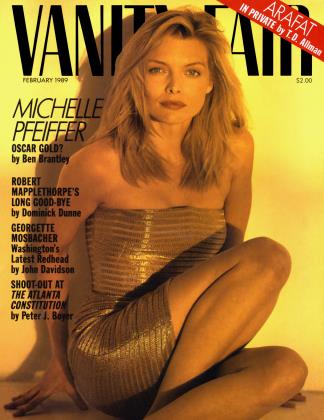Sign In to Your Account
Subscribers have complete access to the archive.
Sign In Not a Subscriber?Join NowGRAPE EXPECTATIONS
Wine
California vs. Oregon in the Pinot Noir stakes
JOEL L. FLEISHMAN
Pinot Noirs, made from the great red grape of Burgundy, can be extraordinarily romantic, voluptuous, and powerful, but their pleasures have always been hard to come by. Pinot Noir is difficult to ferment to perfection, even in France. In the late 1970s and early 1980s, however, a new wave of visionaries, zealous to prove the Pinot Noir's potential on American soil, began impressing the wine world with a succession of genuinely remarkable wines. In California, Chalone's Richard Graff, Calera's Josh Jensen, and Hanzell's Robert Sessions broke new ground with world-class, Burgundy-like wines produced with high consistency. In Oregon, David Lett of Eyrie Vineyards showed the world that his state could do much the same. Today more than two hundred American wineries are making Pinot Noirs.
Oregon has gained something of a reputation as the Pinot Noir state, and in a recent blind tasting of sixty-seven wines for this column, offerings by Arterberry, Elk Cove, Yamhill Valley, Eyrie, Knudsen Erath, Sokol Blosser, and Rex Hill were impressive by any standards. But, overall, the Oregon Pinot Noirs we tasted were inconsistent. As a group they were not as cleanor fresh-
tasting, or as precisely focused, as the Californias were. A few of the Oregon wines are no doubt world-class Pinot Noirs, warranting world-class prices. Most of them are not, and it is regrettable that some of the Oregon winemakers, believing their own hype, have priced the admittedly good Oregon Pinots higher than the dearest Californias, which are considerably better wines.
Despite these shortcomings, the Oregon Pinot Noirs are unquestionably improving. Three years ago, in a similar tasting for this column, only one Oregon winery—Eyrie—showed well. This time, seven vintners produced winners. Two wineries, Yamhill Valley and Rex Hill, excelled. The 1987 Yamhill Valley ($18) starts with a deep, powerful, perfumed nose and delivers wonderfully rich fruit in the mouth. The 1986 ($17) has a similar, but perhaps more elegant, bouquet, followed by pleasantly astringent, chewy, vigorous, and refreshing black cherries and tobacco on the palate. The nose of the 1985 ($17) is dusty and dry, but with lovely fruit fragrances. The 1985 and the 1987 were absolutely stunning on the first retasting. Rex Hill claimed an equal number of victors, with its 1985 Medici Vineyard ($20), 1985 Maresh Vineyard ($18), and 1985 Archibald Vineyard ($25) especially impressive. The only Oregon wine that won first place in a flight was the 1985 Sokol Blosser ($23), with a spicy nose and powerful black-cherry flavors. Others which placed among the top three in their flights were the 1986 Elk Cove ($15), the 1987 Arterberry Maresh Red Hills Vineyard ($14), the 1986 Eyrie ($18), and the 1985 Bethel Heights ($15).
Among California Pinot Noirs, the Caleras are paragons. Produced in the Gavilan Mountains just east of Monterey, they offer consistency of quality across vintages and vineyards. All four of the Caleras in the tasting placed in one of the top three slots in their flights, and every one of them was chosen by
panel members for best-of-tasting status.
All are fairly bursting with easily accessible ripe fruit that tastes clean and crisp. The 1986 Calera Jensen ($25) has a mouth-coating extract of rich, mildly pungent black cherry that is intense and forward. The 1985 Calera Jensen ($25) is spicy and plummy but equally powerful, with just the right frame of tannins. The 1984 Calera Selleck ($25) has explosive flavors of cherry and tobacco, with an amazingly long finish. The 1982 Calera Selleck ($25), selected as one of the two best wines among the sixty-seven we tasted, has a deep, ripe, pungent black-cherry perfume, and, on the palate, fresh, sweet, rich, smoky, velvettextured flavors of that same black cherry laced with tobacco.
There were other California Pinot Noirs that showed extremely well. The 1979 Mayacamas ($20), which has been re-released, is a beautifully ripe, plummy wine with no rough edges, ready for drinking now. The 1987 Zaca Mesa Reserve ($15), from Santa Barbara, is a gorgeous, full-bodied, powerful redand-black-cherry-flavored wine with just an edge of pungency. Also from Santa Barbara, the 1986 Byron Reserve ($16) is enchanting. The 1986 Domaine Laurier ($10), from Sonoma, compels attention with a vigorous red-cherry nose, followed by deep, yet soft, flavors of black cherry and tobacco. The 1984 Edna Valley, from San Luis Obispo ($11), is a stunner, with rich, chewy essences of smoky, ripe black cherries. So is the 1981 ($14), with a velvety texture and perfectly balanced sweet and pungent black-cherry and tobacco flavors. The 1981 Caymus Special Selection ($18), from Napa, tastes young and fresh, with a nose of anise and chewy, spicy, dry black cherries in the mouth. Other notable Californias were the 1986 La Crema Reserve ($20), made from grapes grown in several counties, the 1987 Saintsbury Cameras g ($15) and 1986 Acacia St. Clair ($24), from Napa, and the 1981 Chalone ($22), from Monterey County.
 View Full Issue
View Full Issue


















Subscribers have complete access to the archive.
Sign In Not a Subscriber?Join Now